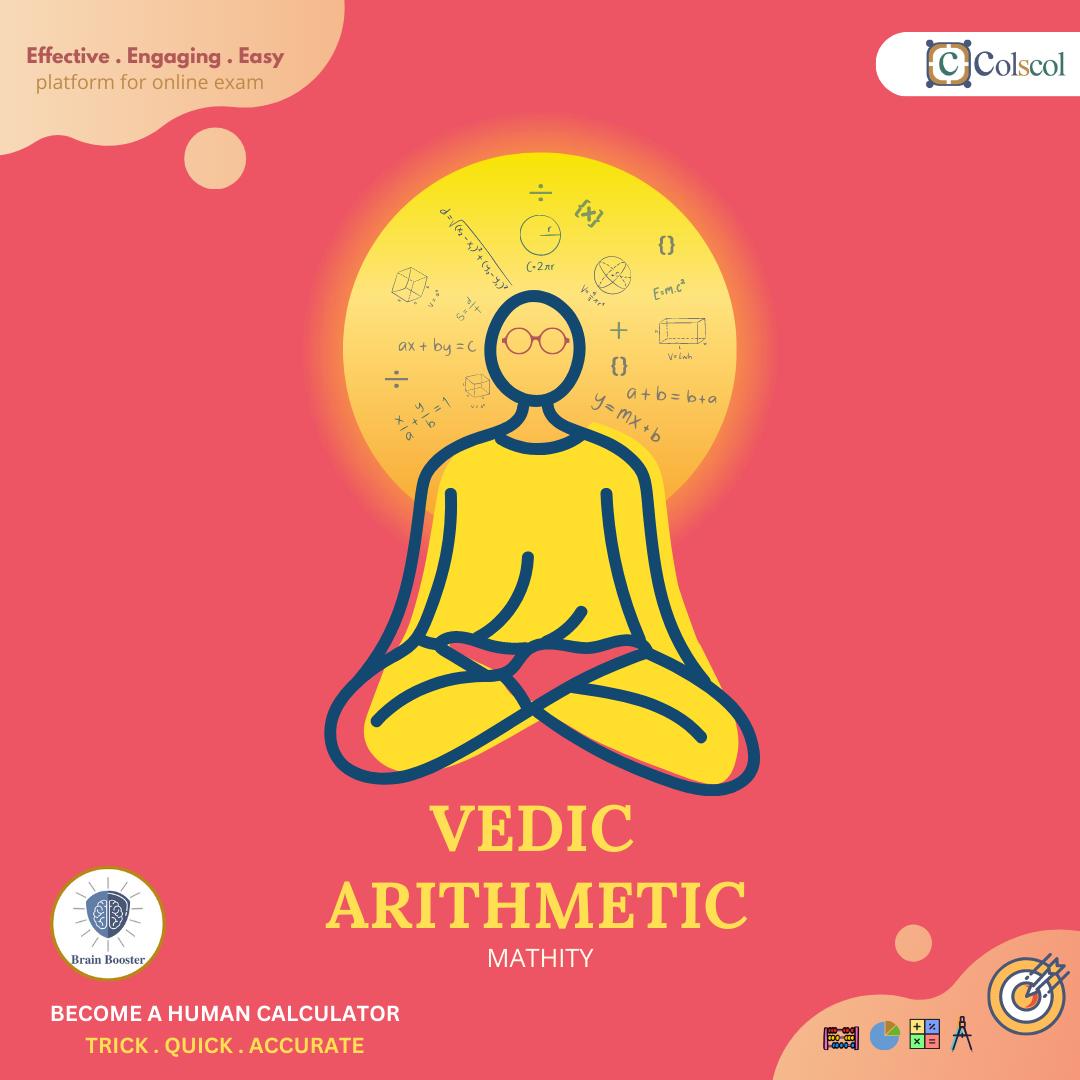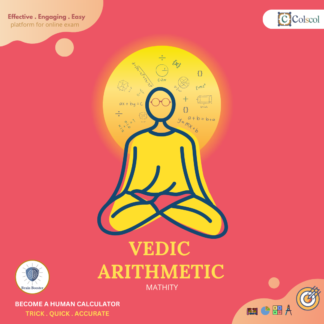Description
Vedic Arithmetic Live Learning Program has been designed by the experts across India that
helps the topics appear in the Competitive exams likes Olympiads, Neltas and other Entrance exams.
Students Learn Tips & Tricks with in depth knowledge of vedic Arithmetic that improves their
Academic maths is a very easy way.
Benefits of vedic Arithmetics
This course enables topic wise Learning with their Academic maths through the (LLP) Live Learning Program .
Course Structure
- LLP Program: Learners learn or interact expert faculty around the nation
- Test Practice: CTS | CWT | CPT
- Report Analysis: View your performance and score compared against highest and average and instantly
- Question Bank : Exhaustive question levels to boost your preparation
About Course14 Strategic TestSyllabusBook Free Demo
- Regular interactive Live Interactive Classes.
- Session will be covered for 40 minutes which is further divided into online daily discussion of next 15 mins.
- Theoretical and conceptual E-learning of 30 minutes, this improves general understanding of the student.
- Competitive Exam provide upto 3 lectures a week subject-wise. Else 2 lectures in a week.
- Study Batch : Individual Study | Group Study
- Test Practice Bank includes Model Test Series , Previous Paper, Tricky Tips
- CTS (Colscol Test Series) Its an Subject-wise Test Program in the based on Competitive exam pattern.
- CWT (Colscol Weekly Test )
- CPT (Colscol Periodic Test )
You can practice test topic-wise, chapter-wise, course-wise and competitive exams as well with world class technology standards.
Grade - 4
- Introduction
1.1 Historyand Benefits of Vedic Maths
- Components
2.1. 10,20,40,50
- Base & Sub-Base Number
3.1 Below Base10 & Above Base -10
3.2 Below Base 20& Above Base -20
- Multiplication
4.1 Multiplication by 11
4.2 Tables of 14,15,13,16,17,18 (General Balancing Method)
4.3 Multiplication by Anthyok Mode (If the sum of units digits is 10 and rest place digits are same)
- Subtraction
5.1 Substraction by Viniculum (all from last 9 from 10)
5.2 Subtraction with complements ( last 9 from 10)
5.3 Subtraction from Base or Sub-base Number
- Addition
6.1 Addition by Mere Observation
6.2 General Addition by Point Method
6.3 Addition in Friends Number
6.4 Addition from LHS to RHS and in Hours & Minutes
- Division
7.1 Division by 9
7.2 Division by 8
7.3 Division by 11
7.4 Division by 12,19
Grade - 5
- Introduction
1.1 Historyand Benefits of Vedic Maths
- Complements
2.1. 10,20,40,50
2.2 100,400….1000
- Base & Sub-Base Number
- 3a.Above Base Method Multiplication
3.1. Below Base10 & Above Base -10
3.2. Below Base 20& Above Base -20
- 3b. Base method multiplication
3.1 Below base 10,20-9,100,200-900
3.2 Above Base 10,20-9,100,200-900
- Multiplication
4.1 Multiplication by 11
4.2 Multiplication by 111
4.3 Dodging 2D x 1D
4.4 Tables of 14,15,13,16,17,18 (General Balancing Methods)
4.3 Table 22,33,44,55
4.4 Multiplication by Anthyok Mode
4.5 Multiplication by Arambha model
4.6 Multiplier has Equal of Nines as Multiplicant Digits
4.7 5DX5D same -11111×11111,33333×33333
- Subtraction
5.1 Substraction by Viniculum (all from last 9 from 10)
5.2 Subtraction with complements ( last 9 from 10)
5.3 Subtraction from Base or Sub-base Number
- Addition
6.1 Addition by Mere Observation
6.2 General Addition by Point Method
6.3 Addition in Friends Number
6.4 Addition from LHS to RHS and in Hours & Minutes
- Division
7.1 Division by 9
7.2 Division by 8
7.3 Division by 11
7.4 Division by 12,19
7.5 Division by 99
7.6 Divisibility Test
- Squares
8.1 Sqaure of number ending with 5
8.2 Square by Duplex Method
- HCF&LCM
- Fraction
- Project
- Revision
Grade - 6
- Introduction
1.1 Historyand Benefits of Vedic Maths
- Complements
2.1. 10,20,40,50
- Base & Sub-Base Number
- 3a.Above Base Method Multiplication
3.1. Below Base10 & Above Base -10
3.2. Below Base 20& Above Base -20
- 3b. Base method multiplication
3.1 Below base 10,20-9,100,200-900
3.2 Above Base 10,20-9,100,200-900
- Multiplication
4.1 Multiplication by 11
4.2 Multiplication by 111
4.3 Dodging 2D x 1D
4.4 Dodging 3D x 1D
4.4 Tables of 14,15,13,16,17,18 (General Balancing Methods)
4.5 Table 22,33,44,55
4.6 Table 19,29,39,49,99
4.7 Multiplication by 5,55,555
4.8 Multiplication by 7,77,777
4.9 Multiplication by Arambha model
4.10 Multiplier has Equal of Nines as Multiplicant Digits
4.11 Short Multiplication of Lesser than 9
4.12 Short Multiplication of more than 9
4.13 4X4D same -6666×6666,9999×9999
4.14 5DX5D same -11111×11111,33333×33333
4.15 Cris Cross Method 2Dx 2D
4.16 Cris Cross Method 3D x 3D
- Subtraction
5.1 Substraction by Viniculum (all from last 9 from 10)
5.2 Subtraction with complements ( last 9 from 10)
5.3 Subtraction for only Zero ( 100/1000) 0
5.4 Subtraction from Base or Sub-base Number
- Addition
6.1 Addition by Mere Observation
6.2 General Addition by Point Method
6.3 Addition from LHS to RHS and in Hours & Minutes
- Division
7.1 Division by 9
7.2 Division by 8
7.3 Division by 11
7.4 Division by 12,19
- Squares
8.1 Sqaure of number ending with 5
8.2 Square by Duplex Method
- Cube Root
- HCF&LCM
- Fraction
- Project
- Revision
Grade - 7
- Introduction
1.1 Historyand Benefits of Vedic Maths
- Complements
2.1. 10,20,40,50
2.2 100,400….1000
- Base & Sub-Base Number
- 3a.Above Base Method Multiplication
3.1. Below Base10 & Above Base -10
3.2. Below Base 20& Above Base -20
- 3b. Base method multiplication
3.1 Below base 10,20-9,100,200-900
3.2 Above Base 10,20-9,100,200-900
- Multiplication
4.1 Multiplication by 11
4.2 Multiplication by 111
4.3 Dodging 2D x 1D
4.4 Dodging 3D x 1D
4.4 Tables of 14,15,13,16,17,18 (General Balancing Methods)
4.5 Table 22,33,44,55
4.6 Table 19,29,39,49,99
4.7 Multiplication by 5,55,555
4.8 Multiplication by 7,77,777
4.9 Multiplication by 9,99,999
4.10 Multiplication by Anthyok Mode
4.11 Multiplication by Arambha model
4.12 Multiplier has Equal of Nines as Multiplicant Digits
4.13 Short Multiplication of Lesser than 9
4.14 Short Multiplication of more than 9
4.15 4X4D same -6666×6666,9999×9999
4.16 5DX5D same -11111×11111,33333×33333
4.17 Cris Cross Method 2Dx 2D
- Subtraction
5.1 Substraction by Viniculum (all from last 9 from 10)
5.2 Subtraction with complements ( last 9 from 10)
5.3 Subtraction for only Zero ( 100/1000) 0
5.4 Subtraction from Base or Sub-base Number
- Addition
6.1 Addition by Mere Observation
6.2 General Addition by Point Method
6.3 Addition in Friends Number
6.4 Addition from LHS to RHS and in Hours & Minutes
- Division
7.1 Division by 9
7.2 Division by 8
7.3 Division by 11
7.4 Division by 12,19
7.5 Division by 99
7.6 Divisibility Test
- Squares
8.1 Sqaure of number ending with 5
8.2 Square by Duplex Method
8.3 Square of 2d & 3d
- Cube Root
- HCF&LCM
- Fraction
11.1 Compairing the fraction
Grade - 8
- Introduction
1.1 Historyand Benefits of Vedic Maths
- Complements
2.1. 10,20,40,50
2.2 100,400….1000
- Base & Sub-Base Number
- 3a.Above Base Method Multiplication
3.1. Below Base10 & Above Base -10
3.2. Below Base 20& Above Base -20
- 3b. Base method multiplication
3.1 Below base 10,20-9,100,200-900
3.2 Above Base 10,20-9,100,200-900
- Multiplication
4.1 Multiplication by 11
4.2 Multiplication by 111
4.3 Dodging 2D x 1D
4.4 Dodging 3D x 1D
4.4 Tables of 14,15,13,16,17,18 (General Balancing Methods)
4.5 Table 22,33,44,55
4.6 Table 19,29,39,49,99
4.7 Multiplication by 5,55,555
4.8 Multiplication by 7,77,777
4.9 Multiplication by 9,99,999
4.10 Multiplication by Anthyok Mode
4.11 Multiplication by Arambha model
4.12 Multiplier has Equal of Nines as Multiplicant Digits
4.13 Short Multiplication of Lesser than 9
4.14 Short Multiplication of more than 9
4.15 4X4D same -6666×6666,9999×9999
4.16 5DX5D same -11111×11111,33333×33333
4.17 Cris Cross Method 2Dx 2D
4.18 Cris Cross Method 3D x 3D
- Subtraction
5.1 Substraction by Viniculum (all from last 9 from 10)
5.2 Subtraction with complements ( last 9 from 10)
5.3 Subtraction for only Zero ( 100/1000) 0
5.4 Subtraction from Base or Sub-base Number
- Addition
6.1 Addition by Mere Observation
6.2 General Addition by Point Method
6.3 Addition in Friends Number
6.4 Addition from LHS to RHS and in Hours & Minutes
- Division
7.1 Division by 9
7.2 Division by 8
7.3 Division by 11
7.4 Division by 12,19
7.5 Division by 99
7.6 Divisibility Test
- Squares
8.1 Sqaure of number ending with 5
8.2 Square by Duplex Method
8.3 Square of 2d & 3d
- Cube Root
- HCF&LCM
- Fraction
11.1 Compairing the fraction
- Creating Pythagorean Triplet
FREE Demo Session
- Duration: 45 Mins Session
- Engage: 1 Session for Free Demo
- Free Live video interactive session to ask questions and find out more about their teaching style – and make sure they’re someone you get on with











Rakesh Kumar –
Hi Colscol Team
This is really good course where my child learn how to do calculation quickly , and the team and faculty are very good
Maahi –
Best for the beginners The course structure is satisfying, helpful course materials, online live support during any day in a week for queries clarifications
manhar Rane –
Very useful…..for examining your preparation a good collection of question and very effectively
Ritik mishra –
I came to know about Colscol Elearn through my friend about “Live Doubt Session ”. I asked my parents & they agreed. When I used Colscol Elearn Doubt Session Program they gave my answer in very explanatory way in real-time interaction
MIHIR MAKWANA –
Systematic approach with the great experience faculty
Inder Parihar –
Best for beginners The course structure is satisfying, helpful course materials, online live support during any day in a week for queries clarifications.
Arpan kumar –
Nice content … very useful …. clear all the concepts with a good question bank of test series …
Very useful…..for examining your preparation a good collection of question and very effectively
Kirti bhai –
Most easiest way to conduct live classes …
Anshu Shah –
I AM VERY HAPPY WITH THE COACHING, VERY HELPFUL CLASSES
Very good and experience faculty for physics … i am from small town and colscol connect me to kota faculty for classes … just like classroom coaching